When the ugly radiator does spoil the interior, the problem can be solved in several ways: replace it with a designer or floor model or simply close it with a screen / box. The latter method has several advantages:
- The screen or box not only hides the bulky design, but often decorates the room.
- Screen / box can be used for the construction of an additional console, shelves for decoration, benches, shelves, desktop.
- A closed battery is safer for children - eliminating the risk of burns and accidental impacts. However, this argument can be argued, because it is in the children's room that the heat loss is needed the least.
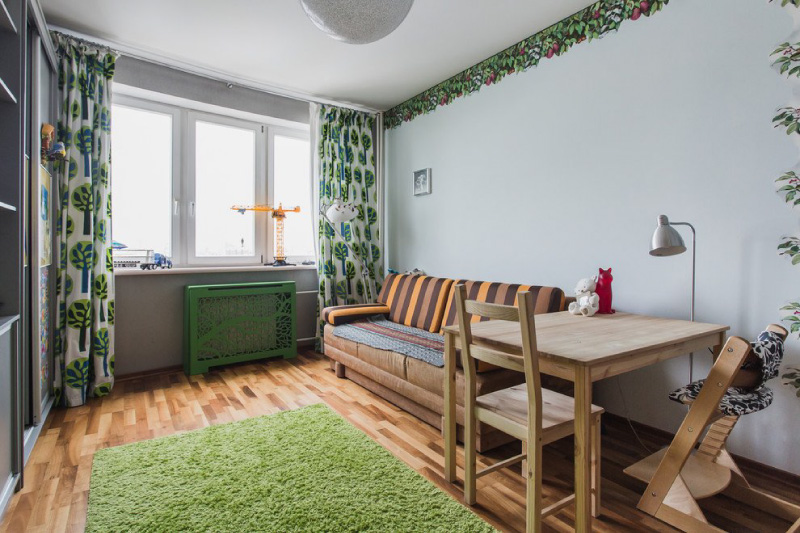
In the children's room, the radiator should be closed with a nice grille with a large number of holes, for example, carved as in this photo.
- If the house is too hot and dry, then closing the battery will help create a comfortable microclimate for households, their pets and plants.
- The screen does not allow dust to settle in the inside of the radiator and thus simplifies cleaning.
There are also disadvantages:
- The heat transfer of a closed battery decreases on average by 10-15% or more (depending on the degree of closeness);
- Screens and boxes often make it difficult to maintain radiators, and sometimes even completely block access to them.
- Often, improperly closed batteries cause windows to fog up and then cause a harmful mold on the slopes and walls.
- Screen or box at least a little, but "eats" the space around the radiator. After all, any elements should be installed at a distance of 5-10 cm from the battery.
- Battery fencing requires additional expenses and hassle.
Further in the article we will describe how to close the radiators without damaging the heat in the house and show 70 photos on the example of how to do it beautifully.
How to close radiators - 11 ways from a drywall box to a screen made of cloth
1. Decorative screen / HDF box
This option is one of the most sought-after due to the average price and beautiful appearance.
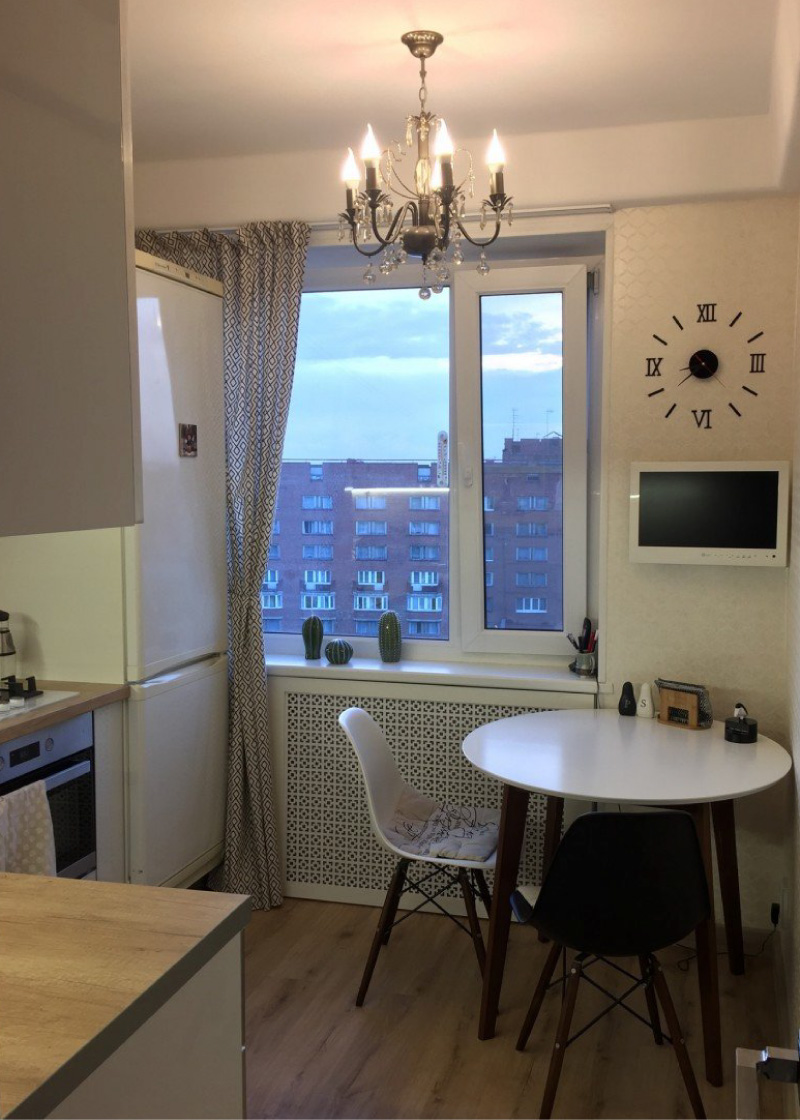
What is the difference from the box box? The screen is designed for the battery, located in a niche or under the window sill (pictured above), therefore, closes only the front part of it. The box also completely covers the radiator on the wall from all sides.
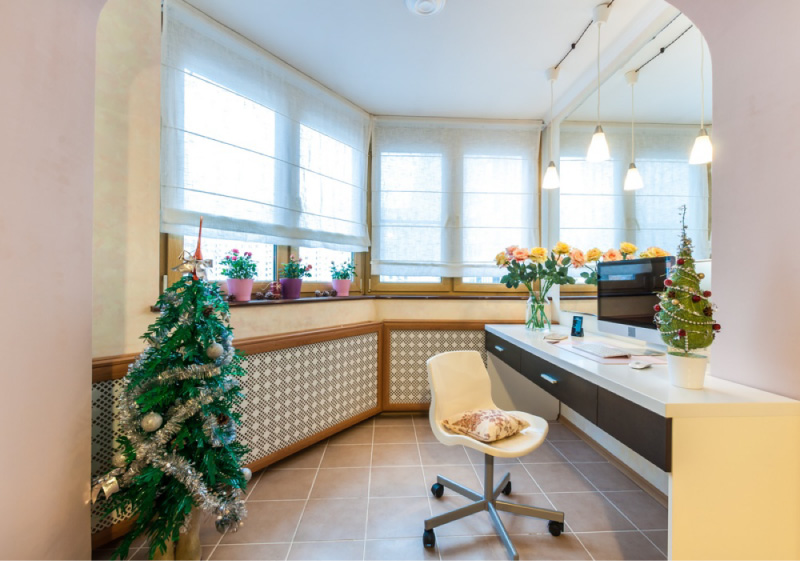
The screen, like the box panel, is made of perforated HDF sheet (HDF 3 mm thick), but the box profiles are made of MDF. Both materials are strong enough, durable and non-toxic when heated.
Benefits:
- Due to the original perforation HDF screens / boxes look beautiful and fit into any interiors, especially in classic.
- Resistance to heat (the design does not crack like natural wood, and does not turn yellow like plastic).
- Easy to assemble and install without the help of experts.
- The finished HDF screens / boxes can be white or imitate wood (wenge, beech, oak), and custom-made screens can be painted in any color, laminated, veneered with natural wood. True, the complexity of the design always affects the price of the screen.
Disadvantages:
- MDF and HDF do not tolerate prolonged contact with water. If the battery leaks or the pipe breaks, the box / screen elements may swell. Therefore, any emergency situations need to be addressed immediately.
- Perforated panels, despite their subtlety, are quite durable due to the high density of fiberboard. However, they must be protected from impacts and sharp objects.
- The perforation sections in the factory screens are not colored, and therefore visible.
Price: from 1500 rubles for the finished model and from 2300 rubles for an individual order.
Tips for choosing:
- The size of the radiator niche should match the size of the inside of the screen.
- Screens and boxes for the battery can be either finished (assembled as a designer), or made according to individual dimensions and design (you can choose a perforation pattern).
Here is a small selection of photos of closed batteries.
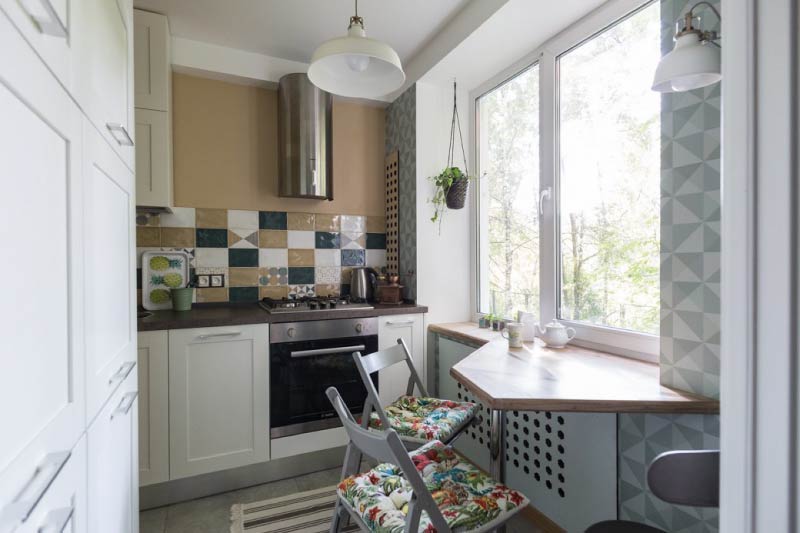
Closed battery in the interior of a small kitchen in Khrushchev
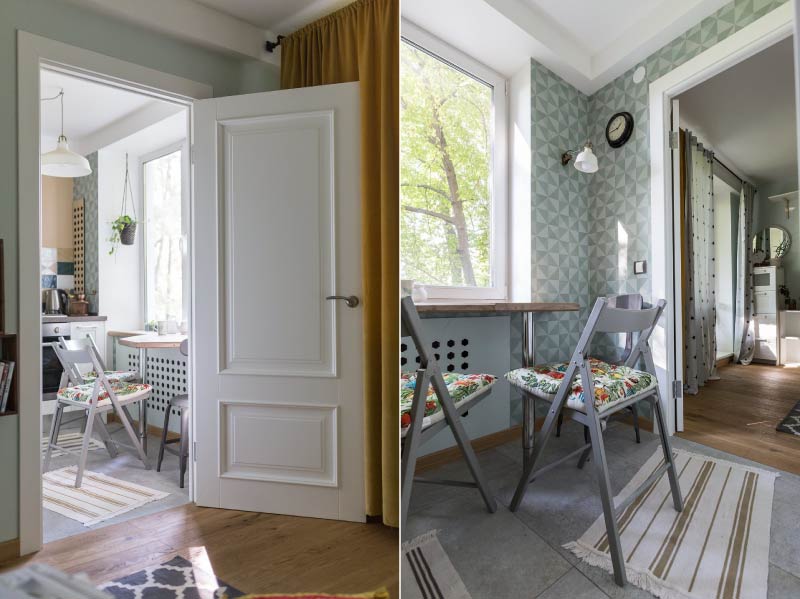
Screen for the battery under the window-bar counter
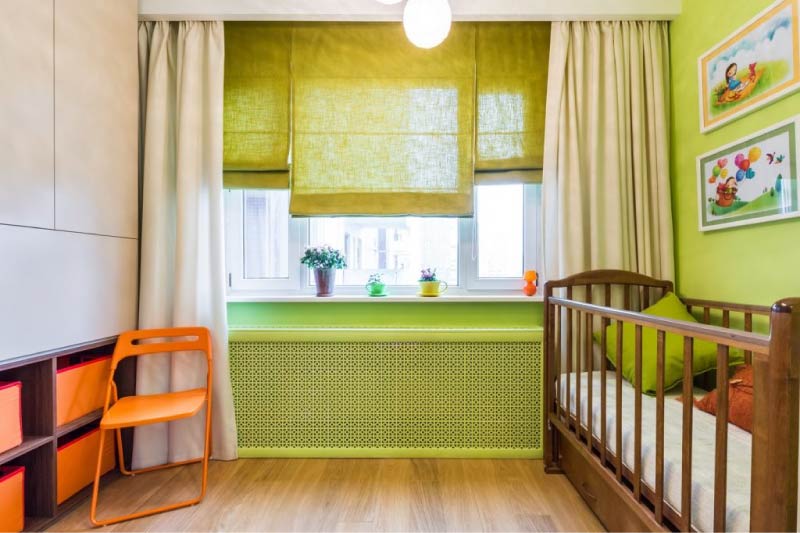
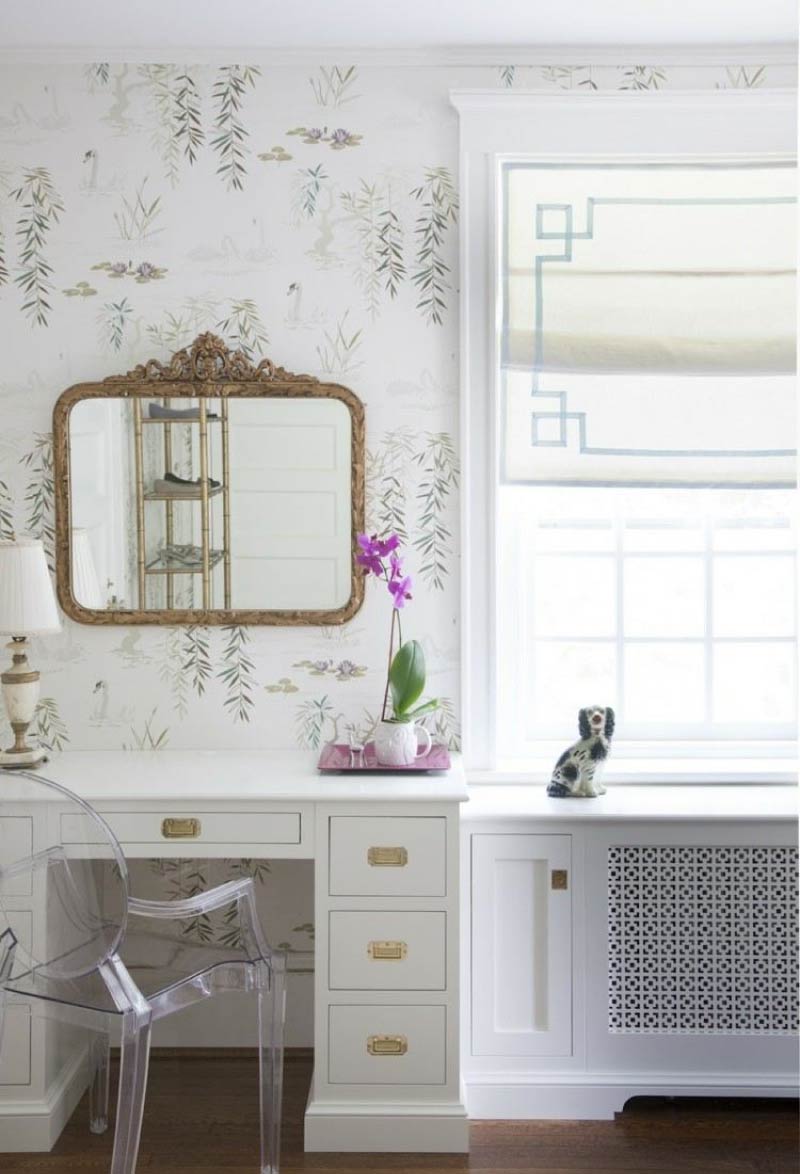
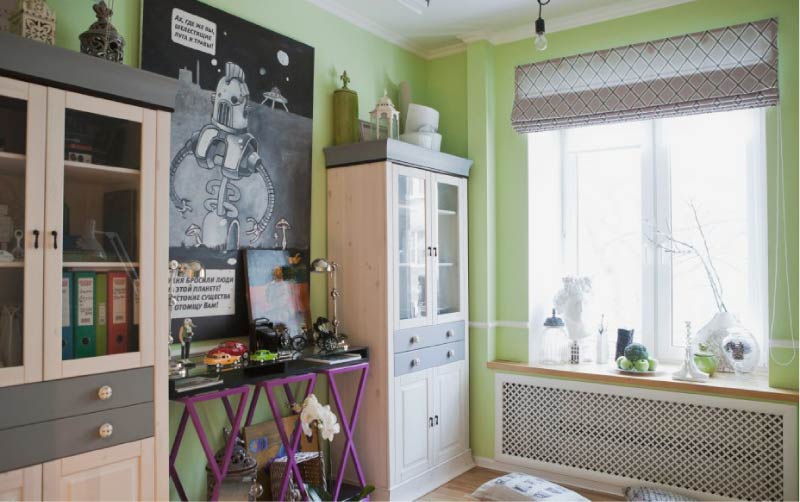
2. Drywall Box
How to close the battery with drywall? With this material, you can sheathe a radiator box or create a niche for it in a false wall.
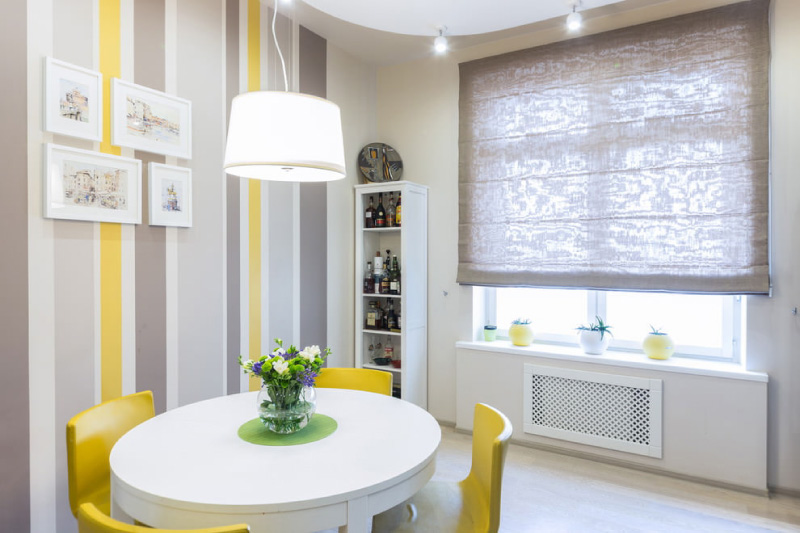
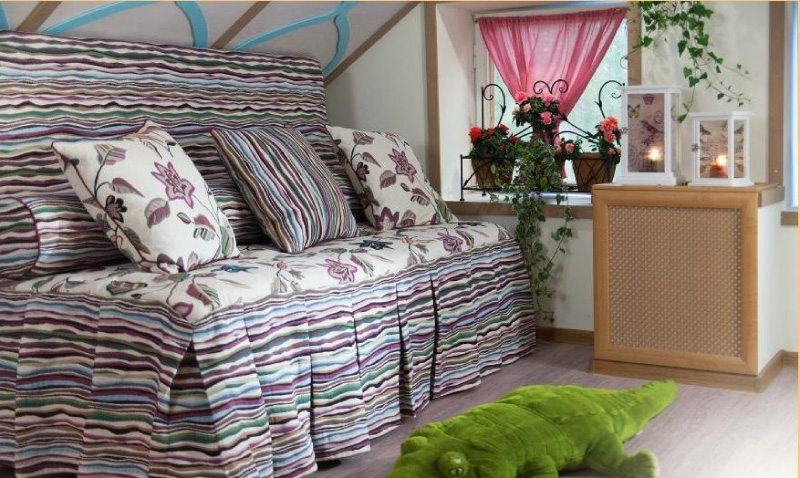
Benefits:
- Environmental friendliness;
- Can be used in wet areas;
- Material is available;
- False-wall can close the pipe, expand the window sill;
- You can close the battery with a drywall can do it yourself without special skills for a few hours;
- The configuration of the box and false walls can be thought out on your own, if you wish, you can equip it with shelves and niches, and you can also close the pipes connected to the battery. Next, you can view a photo of a closed battery in a plasterboard false wall with an enlarged window sill-bench and a built-in niche for books.
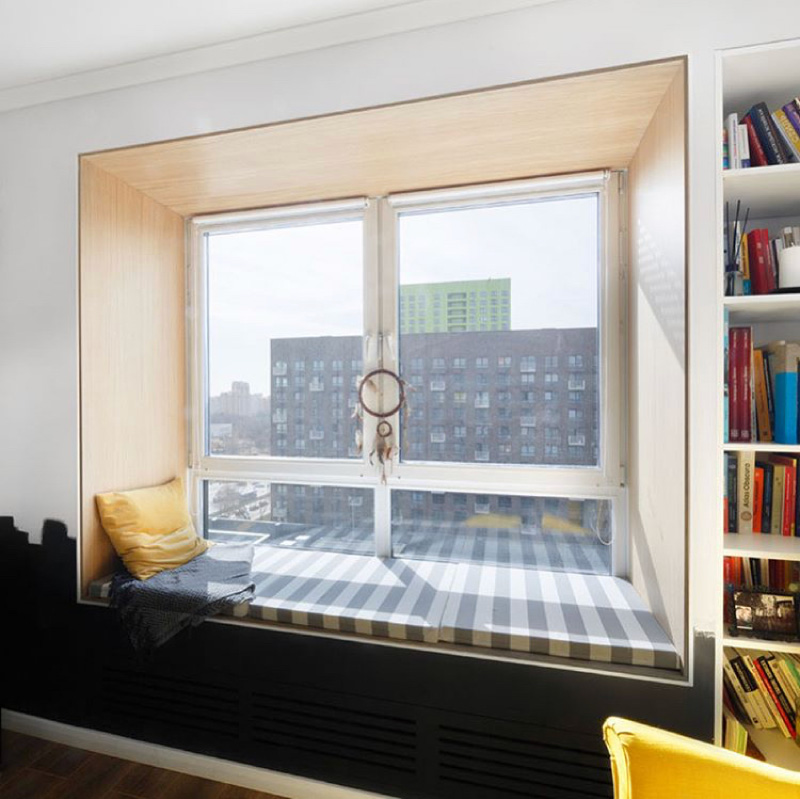
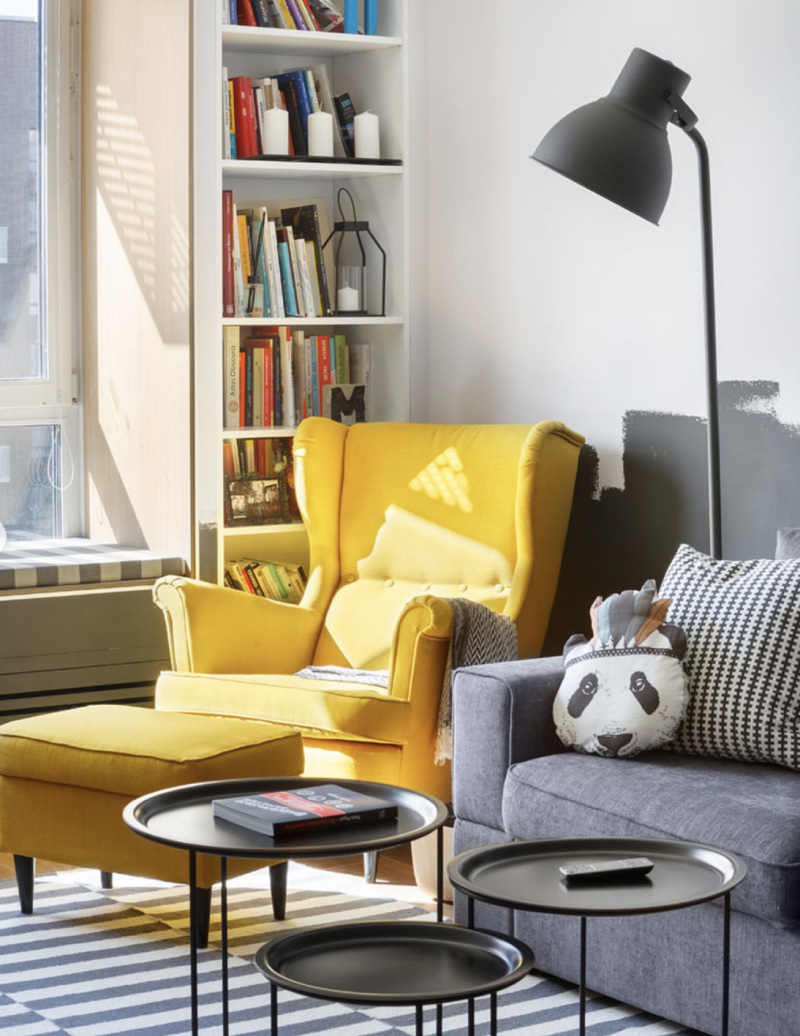
Disadvantages:
- The main disadvantage of the drywall box is that this material is afraid of shocks and leaks. If something goes wrong, you will have to completely change the battery lining along with the trim.
- A false wall for plasterboard for a battery and pipes “eats” the space, as it is moved 30-35 mm forward from the extreme point of the radiator.
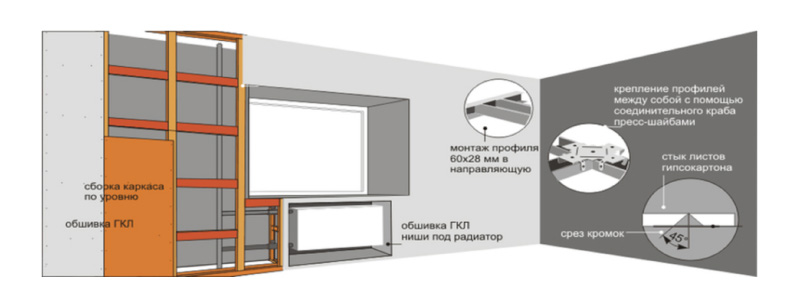
- As a rule, the box from the Civil Code should be done at the repair stage, because its decoration should coincide with the wall decoration.
In the following photos you can see the finished kitchen interior with a closed battery and a box of plasterboard in the process of repair.
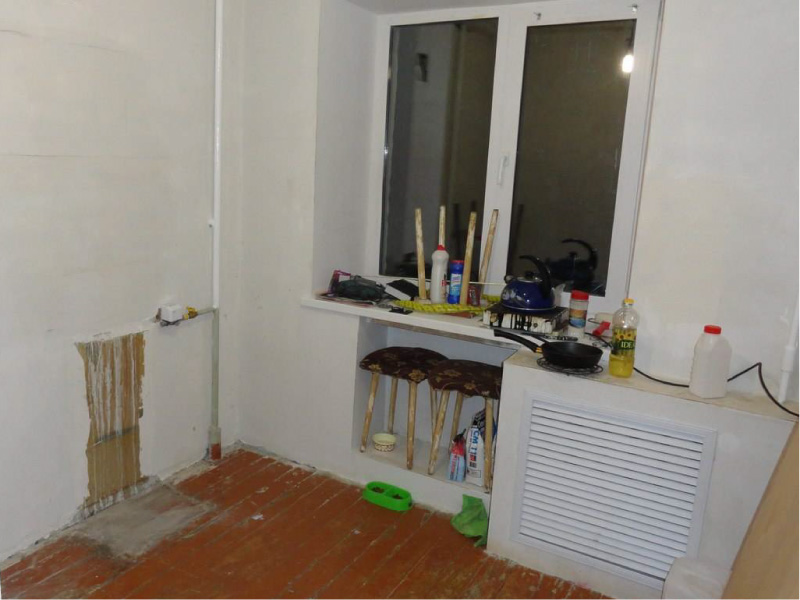
Design and manufacturing tips:
- Before closing the radiator with a drywall box, be sure to tidy it up: blow it out, rinse it (this is done at the end of the heating season) and paint it. In the future, it will be difficult or even impossible to do this without dismantling the box.
- The box can be installed in the floor or "hang" on the wall.
- When designing the box, please note that the sill visor should protrude not less than 30 mm above the facade of the box. If necessary, the old window sill should be replaced with a wider one.
Visual instruction on how to close the battery and pipe with a false-wall plasterboard is presented in the video below.
But the video lesson on how to close the radiator box.
3. Furniture
In the kitchen, a battery with a window sill can be built into a set or bar counter, and in the living room, bedroom and hallway - into a bench, console or shelving unit.
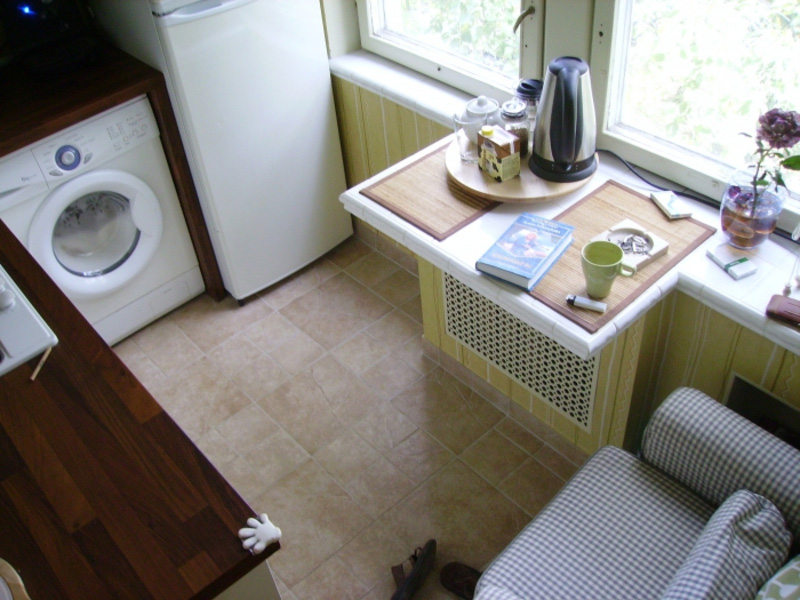
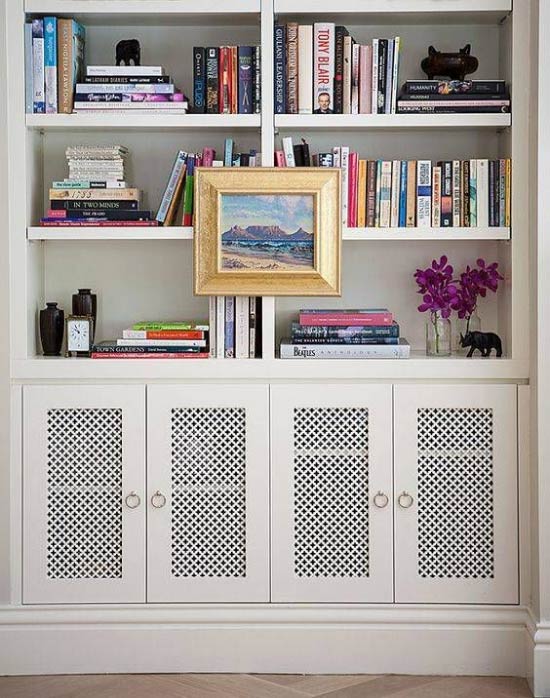
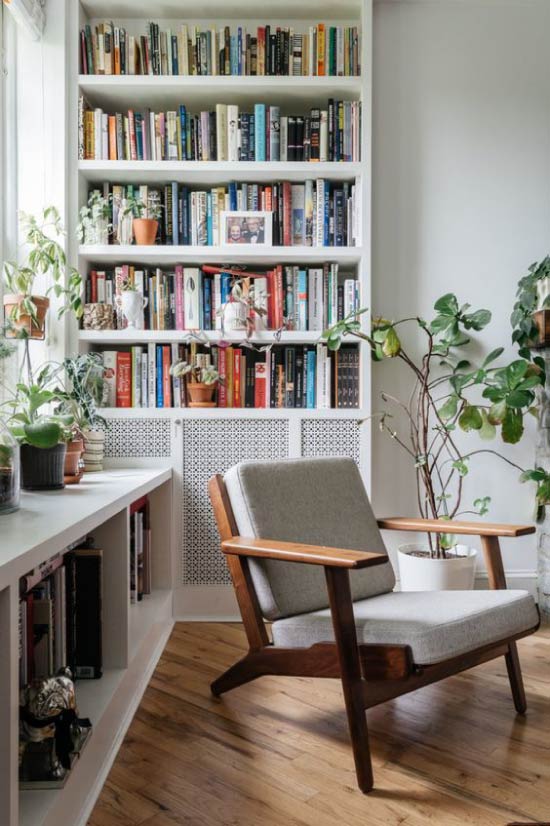
This slider presents a selection of photos of closed radiators under the bench.
- The main condition: in the window sill / cover above the battery, you need to provide enough holes for air circulation, and equip the facade (if any) covering the battery with a grille (see photo below). Otherwise there is a risk of windows fogging and cold in the room.
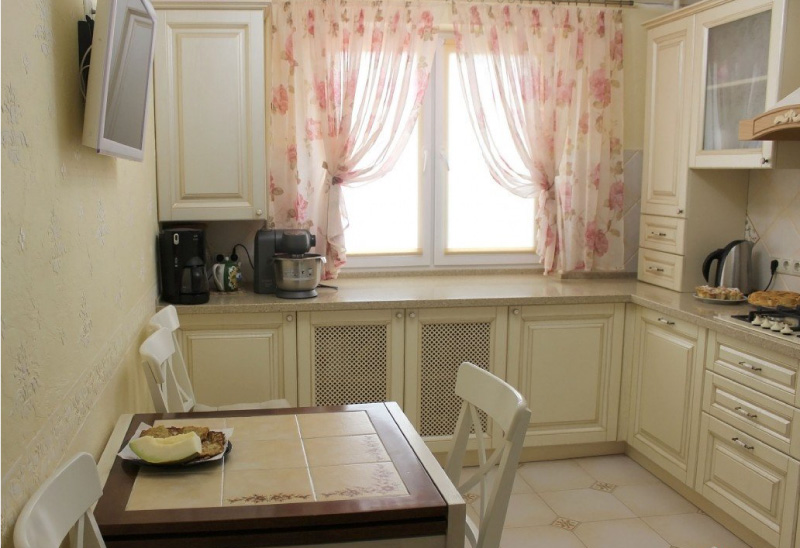

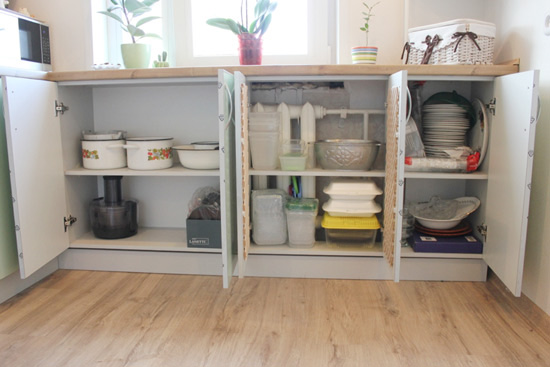
Sometimes in order to hide the radiator, it is enough to rearrange the furniture and close the device, say, a sofa, an armchair or a console.In order not to disturb the air circulation, it is better to put a piece of furniture away from the battery (at least 10 cm); it is also desirable that it be on its feet - so convective currents will not be blocked.
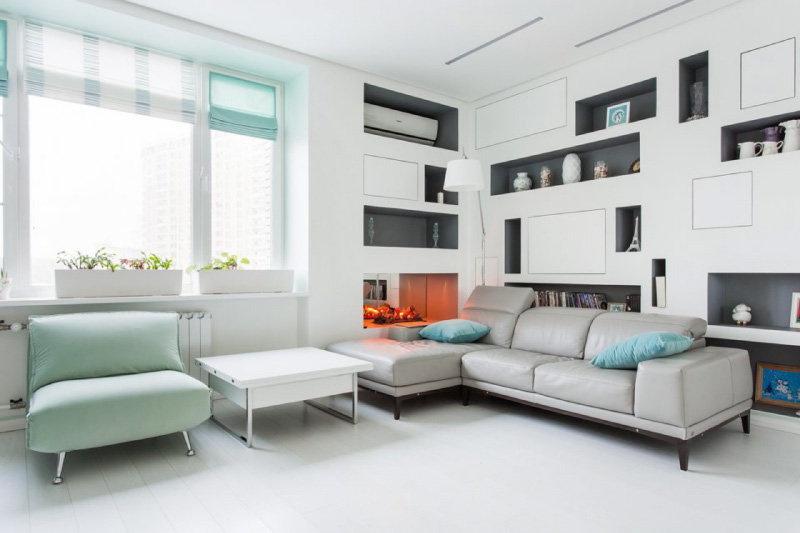
4. Cloth curtain
This way of masking is good for rental housing, or when you need to solve the problem of ugly batteries with minimal costs. The advantages of the curtain are obvious: a piece of fabric is inexpensive, and the choice of colors is very large (you can change the "screens" according to your mood), while the battery is always available for repair and inspection.

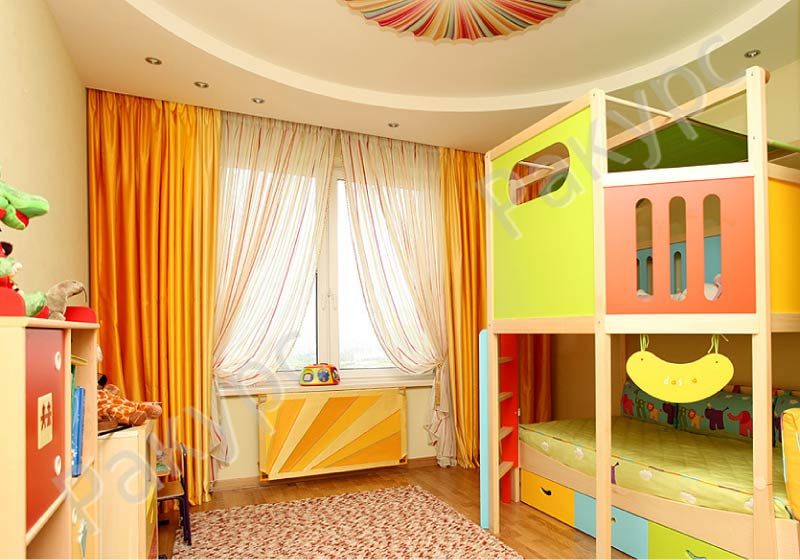
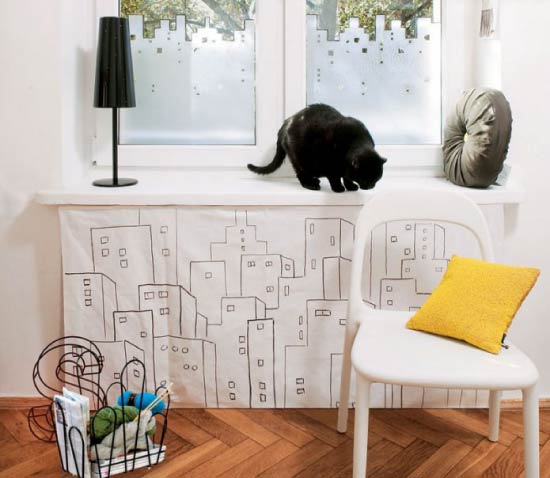
5. Natural wood screen
Benefits:
- Beautiful and expensive appearance even in the simplest version;
- Environmental friendliness;
- Good heat dissipation and the ability to accumulate heat.
Disadvantages:
- A tree is capricious - a poorly prepared tree can swell from a leak or warp from heat;
- Wooden screen requires special care;
- High price.
Prices: from 3000 rubles for the simplest models and from 10 thousand rubles for premium wooden screens.
Here are some photos of beautifully closed batteries.

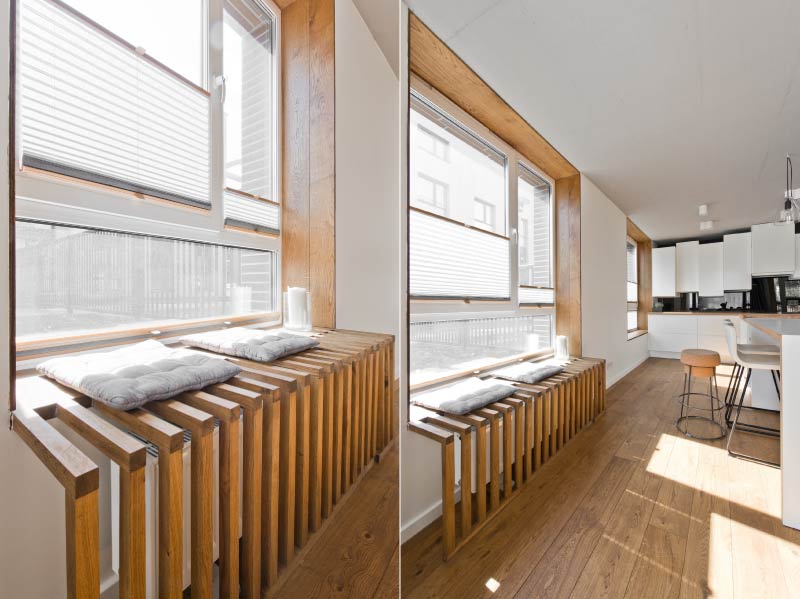
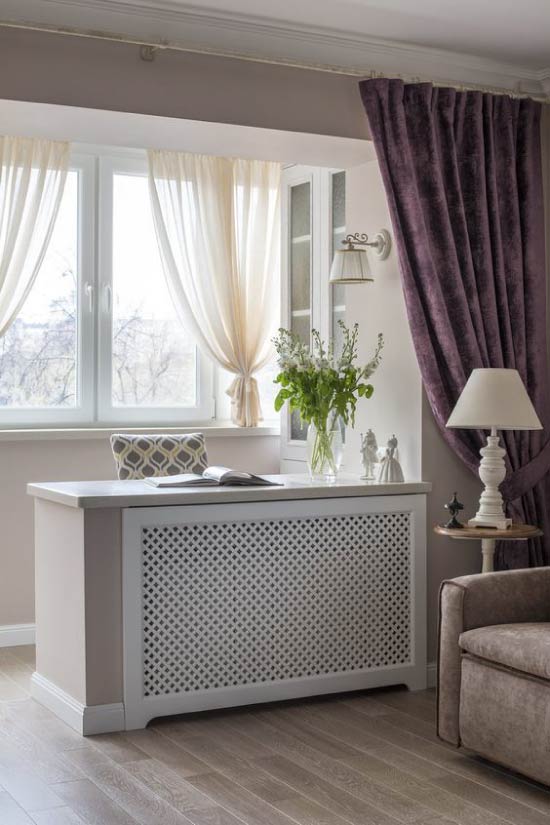
6. glass screen
The glass screen is an excellent decoration solution, but from a thermal point of view it is very controversial.
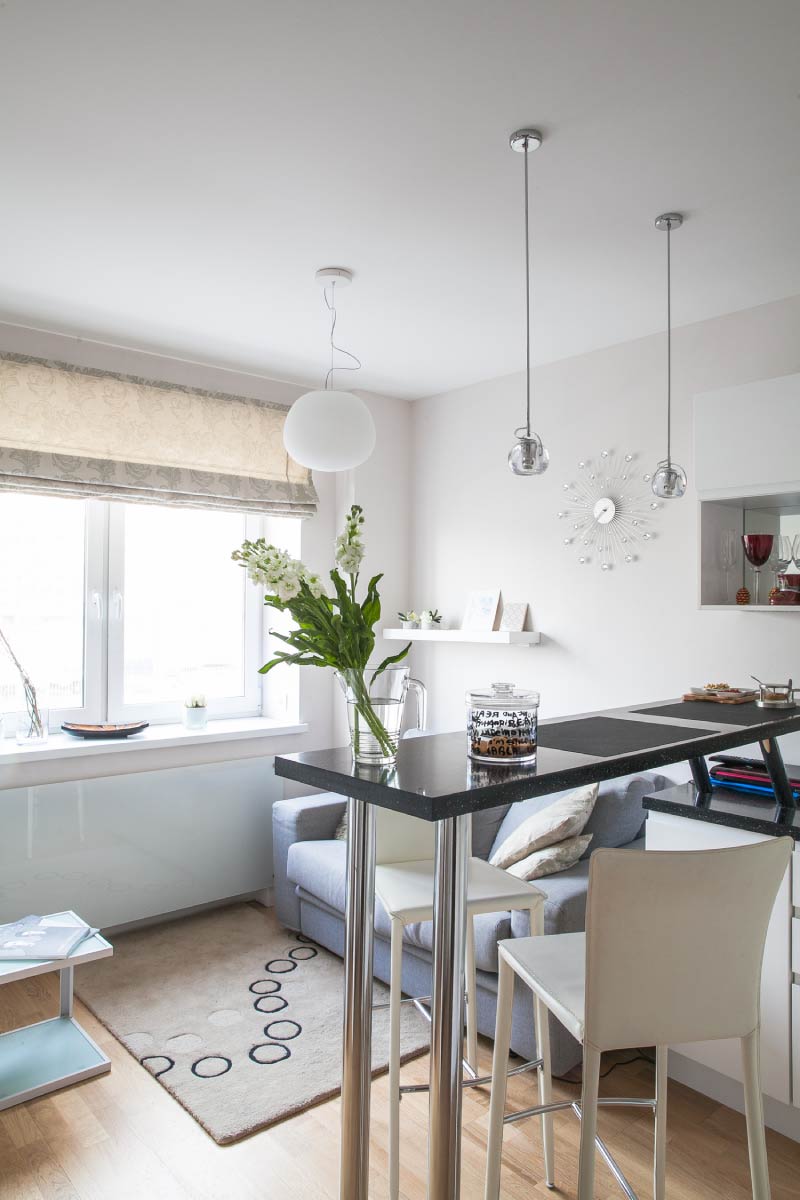
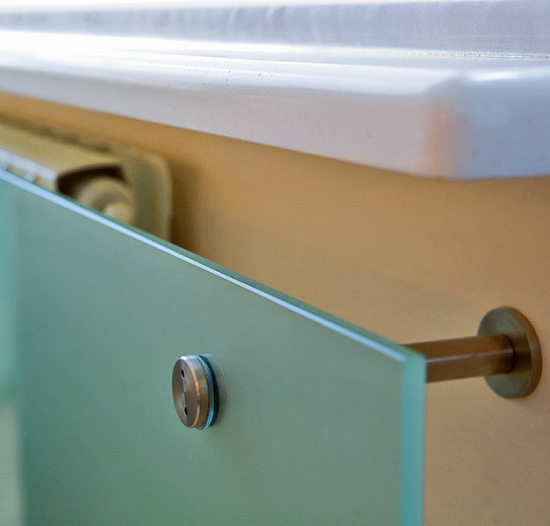
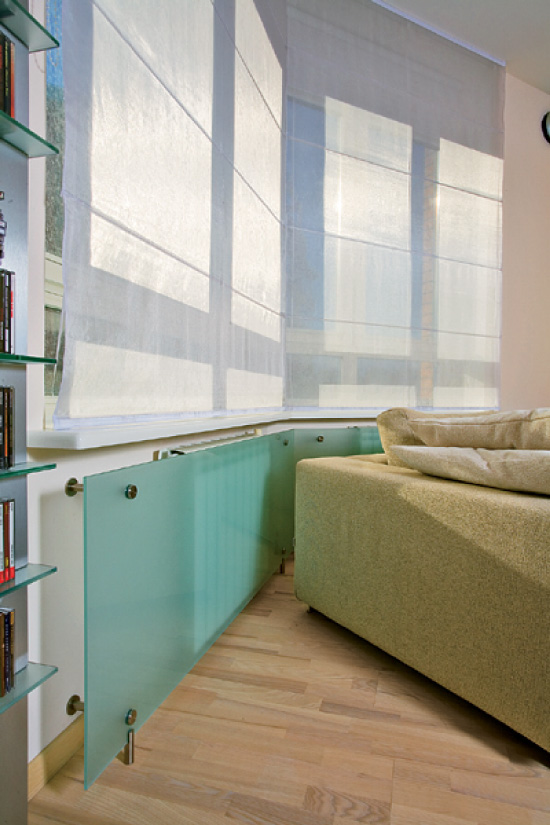
Benefits:
- Design for every taste - the glass panel can be transparent and colored, matte and shiny, with or without a sandblast pattern, with facet or polished edges;
- Glass may look neutral or very bright;
- Glass visually looks easy and adds airiness to the interior;
- Ease of care;
- Strength;
- Durability;
- Heat resistance;
- Moisture resistance;
- Absolute environmental friendliness.
Disadvantages:
- More suited for modern rather than classic interiors;
- "Eats" up to 40-50% of heat (infrared radiation);
- High price;
- Fingerprints may remain on the glass;
- The panel does not close the ends of the battery;
- Installation of the screen often requires the assistance of a specialist.
Tip:
- The screen for the battery should be made of tempered glass only. Only in this way it will be absolutely safe and impact resistant.
- The glass screen is good to use in rooms with excessive heat.
7. Metal box
Benefits:
- Practically do not interfere with heat exchange;
- Low price;
- Easy care;
- Absolute moisture and heat resistance.
Disadvantages:
- "Office" appearance that does not fit into every interior.
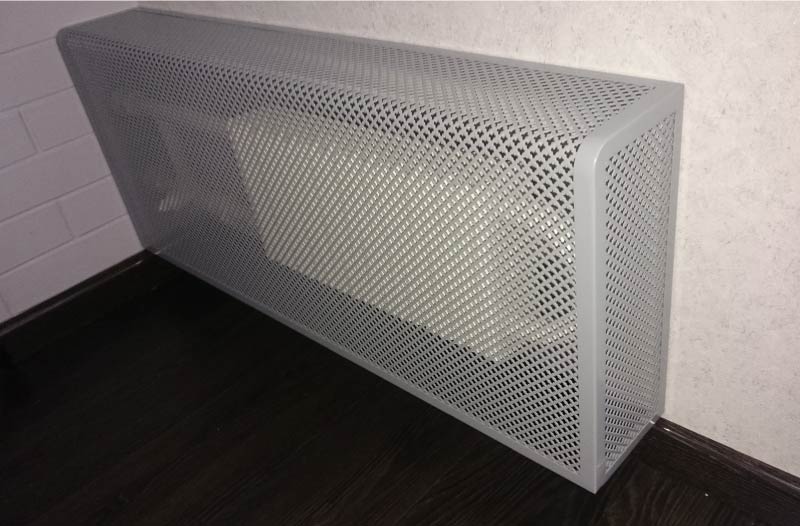
Tips for choosing:
- A metal screen for a battery can look very nice if ordered to make it at a company specializing in laser metal cutting or forging.
8. Rattan box or screen
Most often under the rattan cloth imply a grid of artificial rattan, woven from fibers based on cellulose reinforced with nylon thread. Artificial rattan is very similar to natural, but unlike it is more practical and should be painted in any color. Natural rattan screens have natural beauty and durability, but they are 2 times more expensive, and it is much more difficult to find them on sale.
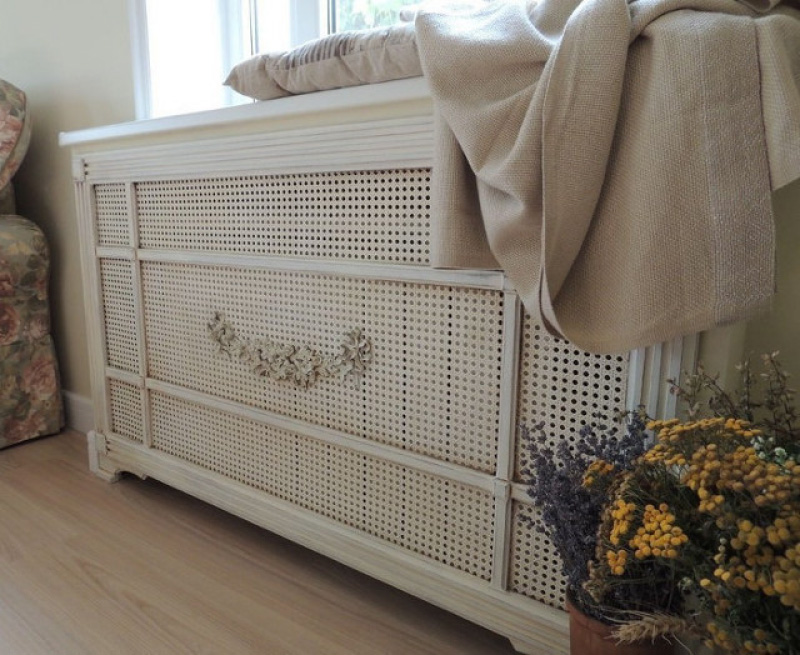
The advantages of the rattan screen:
- Environmental friendliness;
- Beautiful view;
- Strength;
- Elasticity;
- Good heat dissipation.
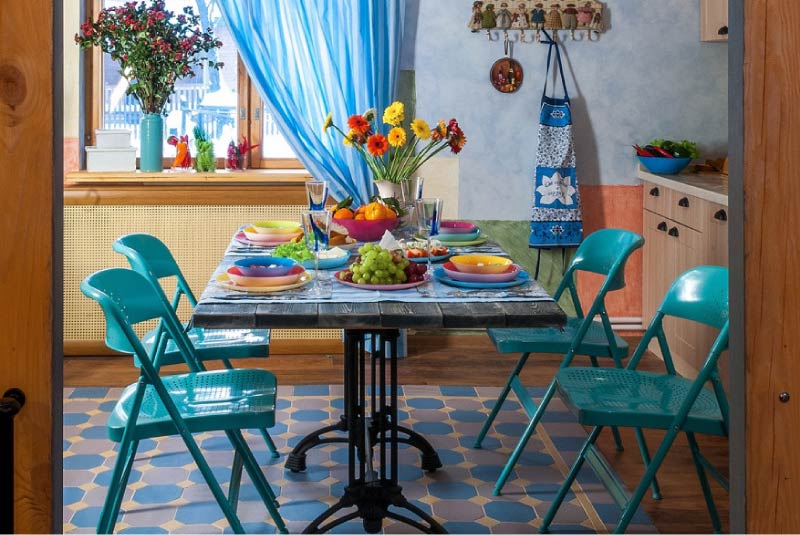
Disadvantages:
- Weaving artificial rattan is quite dense, which can affect the heat transfer;
- The screen must be protected from water.
Prices: from 1,700 rubles (artificial rattan screen).
Tips:
A rattan cloth (both artificial and natural) can be used to make a battery screen with your own hands. To do this, you need to assemble the corners of the box with the frame, attach a grid to the inside of the frame, then install the box on the radiator with the help of brackets.
9. Attached metal screen
The metal construction consists of a cover and a screen and is hung on top of the battery without fixing.
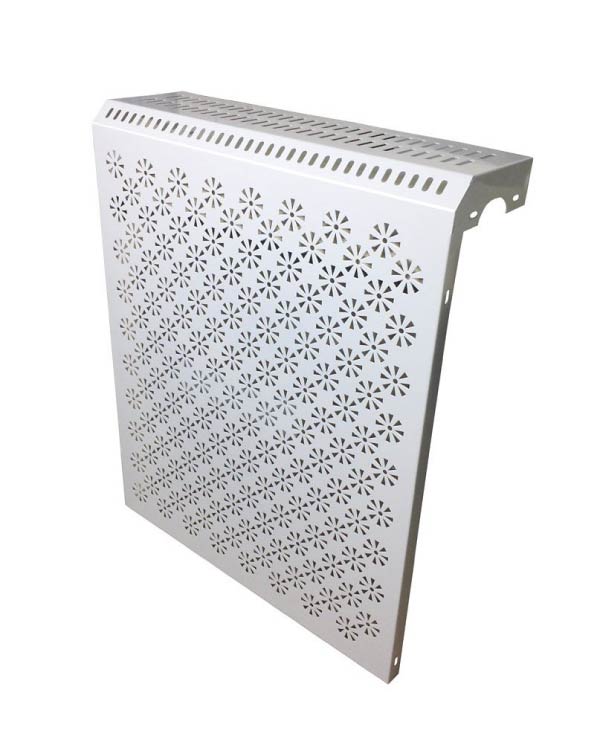
Benefits:
- Easy installation;
- Easy disassembly, which facilitates radiator maintenance;
- Profitable price;
- Durability;
- Does not reduce battery performance.
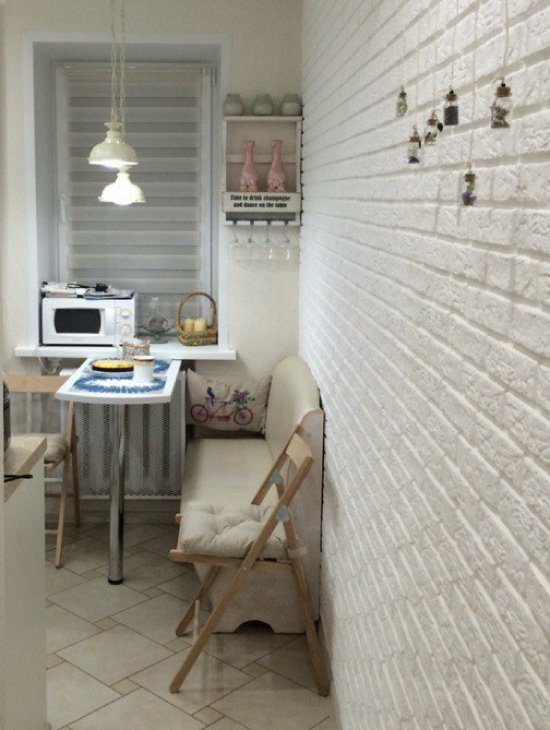
Disadvantages:
- The ends of the battery remain visible;
- Almost always suspended screens are lattices without any decorative effect.
Tips:
- Must be quality enamel, not scratched;
- Must hold tight and easy to remove;
- Screen metal should not corrode.
10. Curtains to the floor
Radiator masking with curtains is a great idea, approved by both heat engineers and decorators. The only problem is that hiding the battery under the window behind the curtain, without obscuring the room, will not work. Is that hang very light tulle as in this photo.
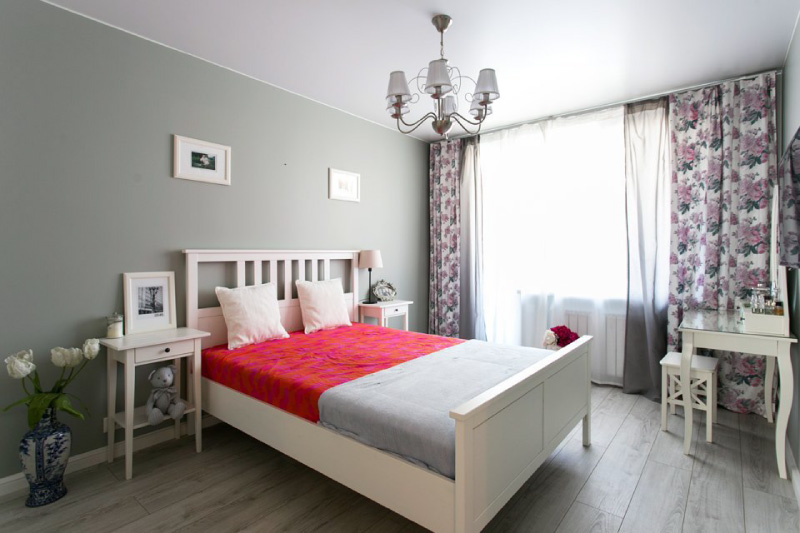
Battery behind the curtains in the bedroom
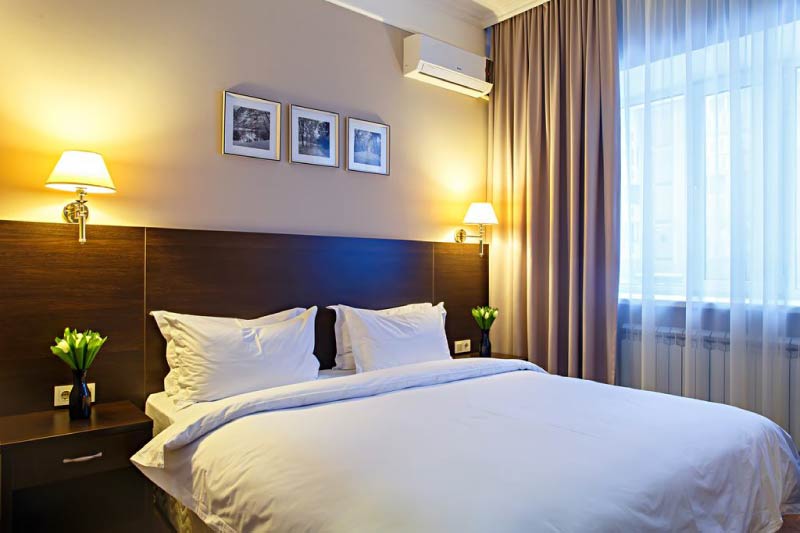
Especially well hidden behind the curtains are vertical radiators. If you are decorating the interior from scratch, consider replacing the standard battery with such a model.
11. Plastic panel
Benefits:
- Installation in 10 minutes without a specialist;
- Easy disassembly;
- The ability to independently change the size of the panel;
- Suitable for kitchens, bathrooms and toilets, that is, rooms with high humidity;
- Affordable price.
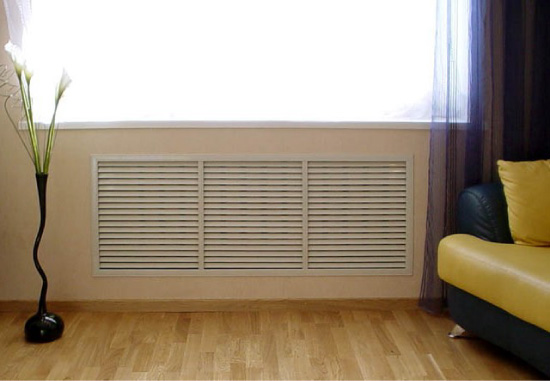
Disadvantages:
- It looks simple, no frills;
- Over time, the plastic may turn yellow;
- From heating, poor-quality plastic can release toxic substances, such as formaldehyde.
Prices: from 300 rubles.
Tips for choosing:
- Plastic screens for batteries are available in basic colors: white, gray, brown, beige. If desired, the screen can be painted in the desired color alkyd spray paint on plastic;
- When choosing a plastic screen for a battery, make sure it is heat resistant and non-toxic.
How to close the batteries correctly - technical rules and tips
Before you close the heating battery, you need to consider a few technical details:
- Keep in mind that the heat transfer of a closed radiator is reduced in any case, no matter what masking method you choose. The main thing is that the change was not significant. Ideally, the decrease in air temperature in the room should be about 1-1.5 degrees.
- Before you close the battery, put it in order: blow, rinse (this is done at the end of the heating season) and paint.
- Keep in mind that the denser the lattice weaving, the better it masks the radiator, but the worse it conducts heat. Therefore, when choosing a screen for a battery, try to look for a middle ground or rely on heat saving.
- To minimize heat loss, the screen can be put on the legs, and in the center cut the groove.
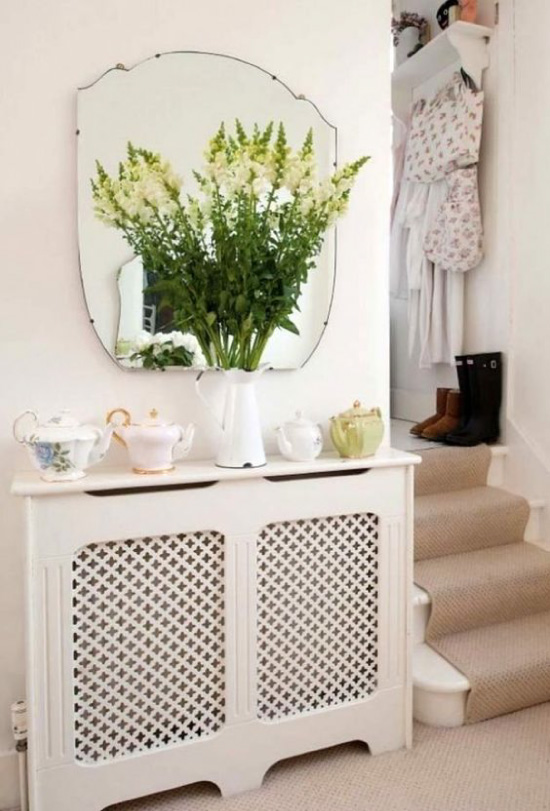
- When closing the battery, it is very important not to block convective air flows, otherwise the room will blow, and the windows will start to fog up, which will eventually lead to the appearance of mold on the walls. Ideally, the sill visor should protrude no more than 30 mm above the batteries, the top and bottom of the battery should be as open as possible.
- Between the battery and the screen there should be a distance of at least 35-50 mm. From the radiator to the floor and to the window sill there should be a gap of about 60-70 mm.
- To solve emergency situations, it is necessary to provide free access to the radiator. For example, the box grille can be removable, foldable (see photo), opening on hinges or sliding on profiles.
At a minimum, for trouble-free maintenance, the following must remain in good accessibility: pipe joints, valves, thermal head and threaded connections.
- Increase heat transfer by 20-25% can be placed on the wall behind the radiator heat-reflecting screen, for example, fumisol. Often this is enough to fully compensate for the heat loss of a closed battery.
- How to decorate or hide the pipeline in the kitchen
- Kitchen design and repair in Khrushchev - 13 tried and tested solutions
- Choosing a kitchen faucet
- Choosing a kitchen sink in 5 easy steps.
- Installing the kitchen sink - instructions, tips, video
- Corner kitchen sink - selection and installation

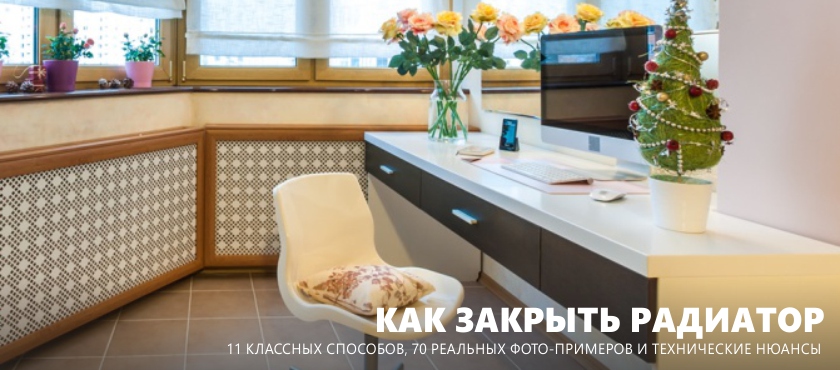
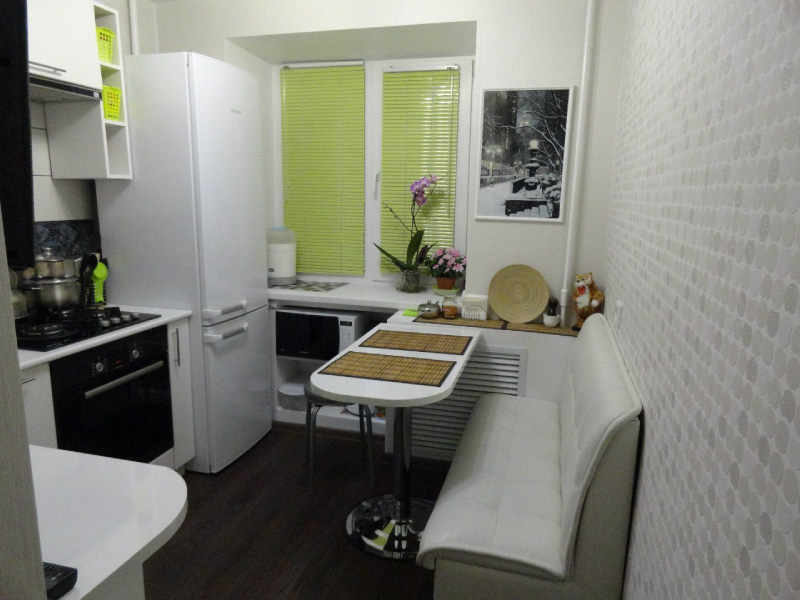
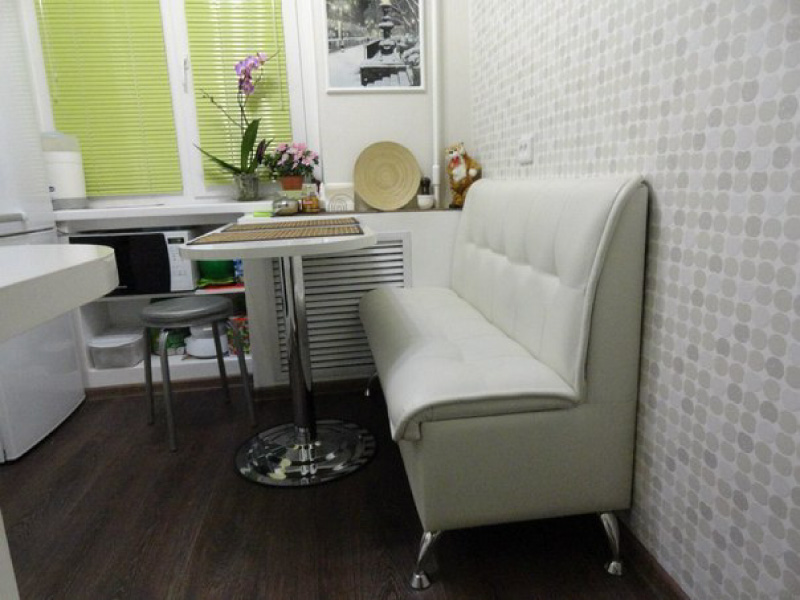
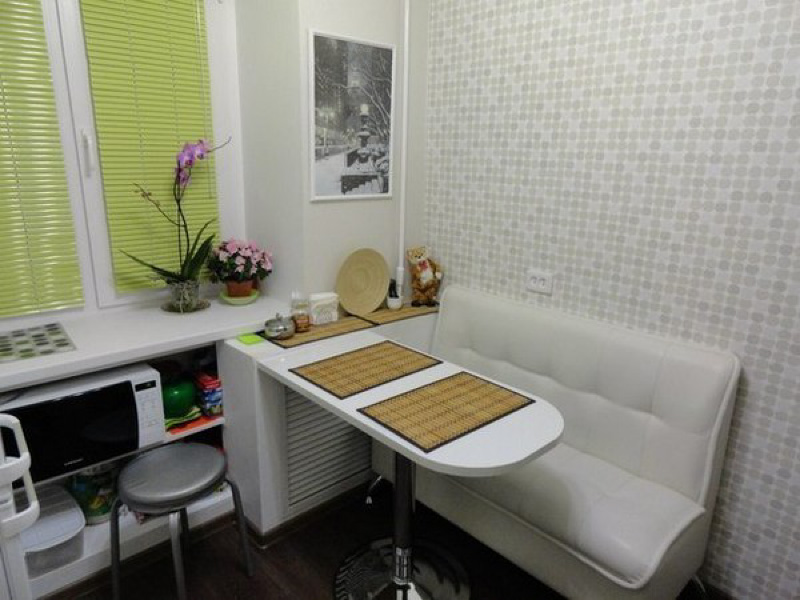
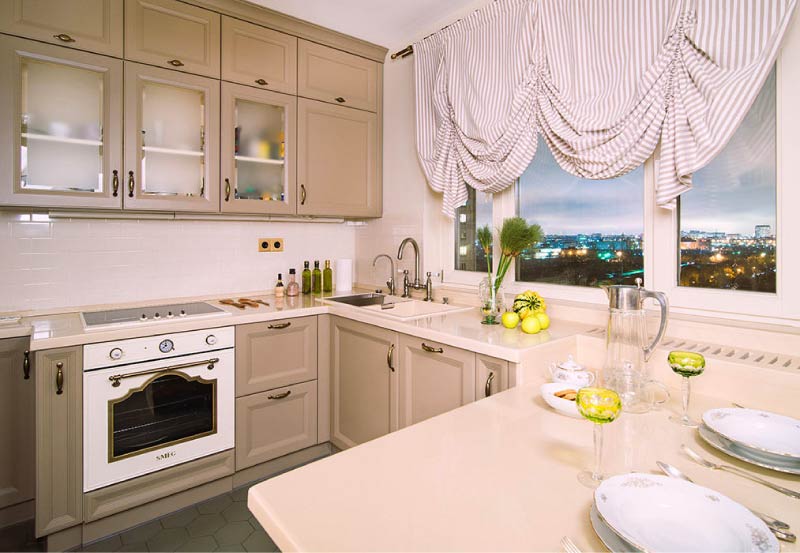
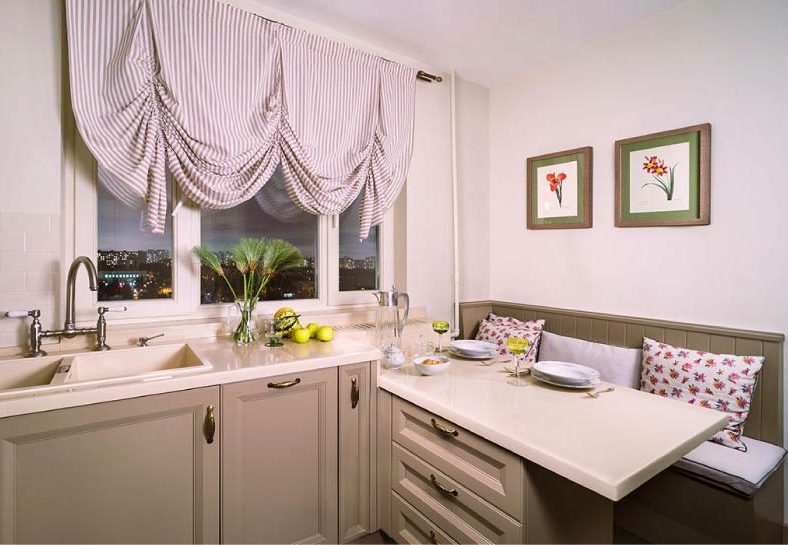
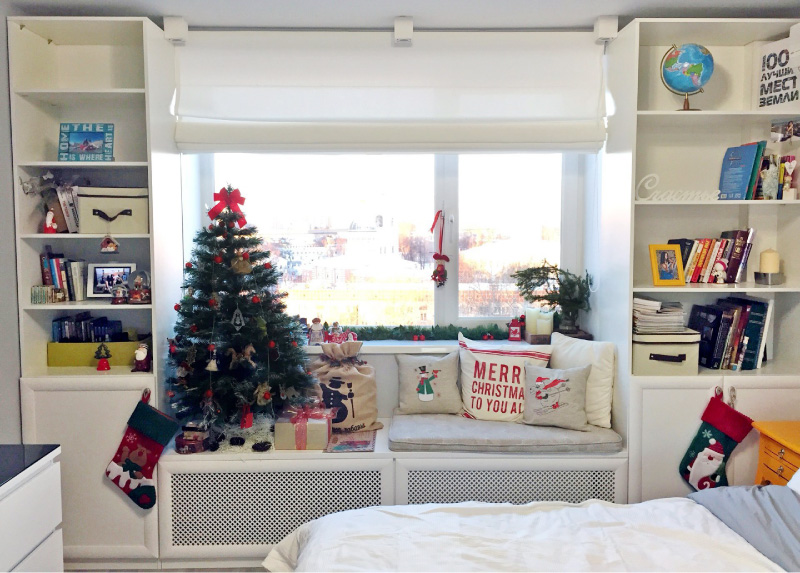
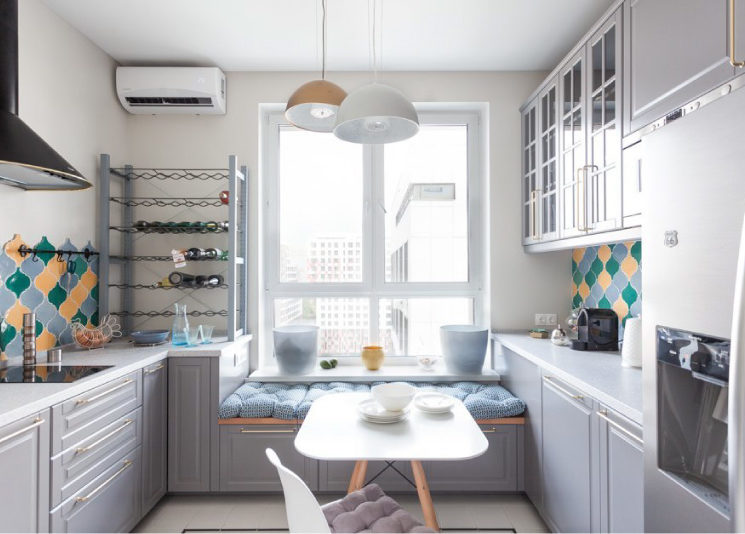
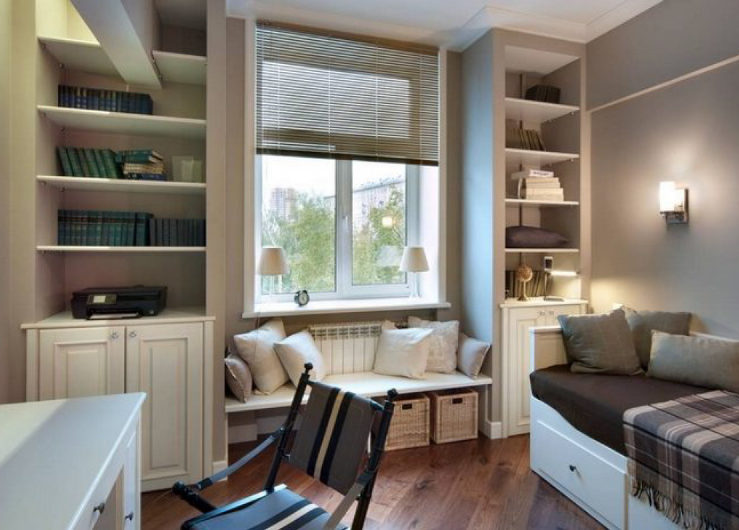
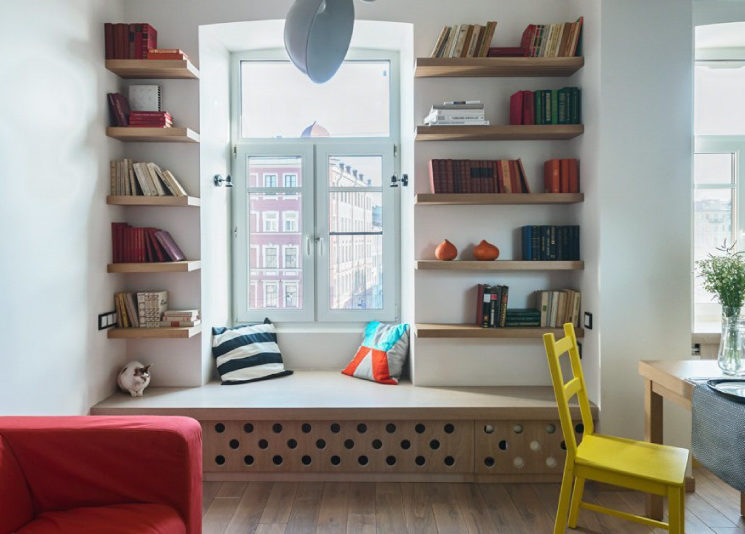
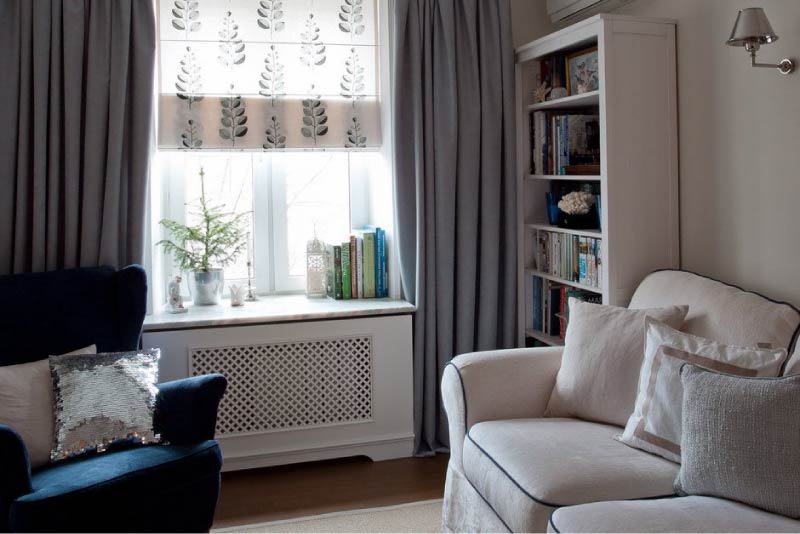

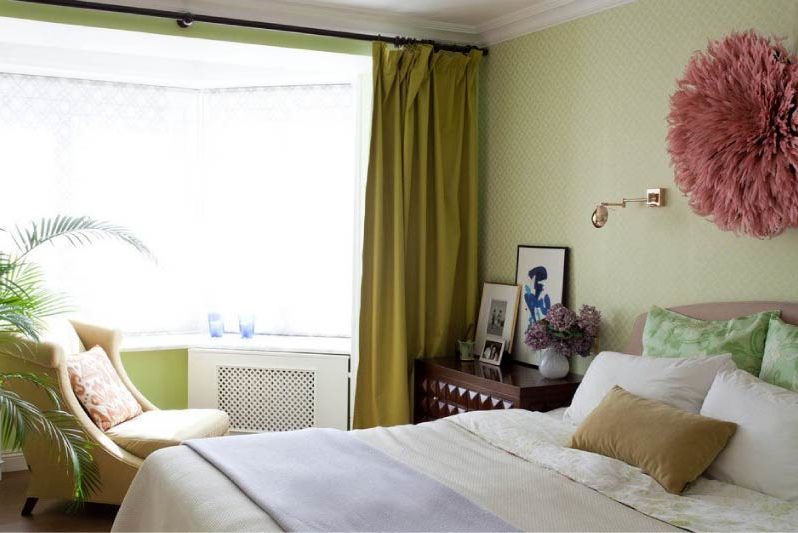
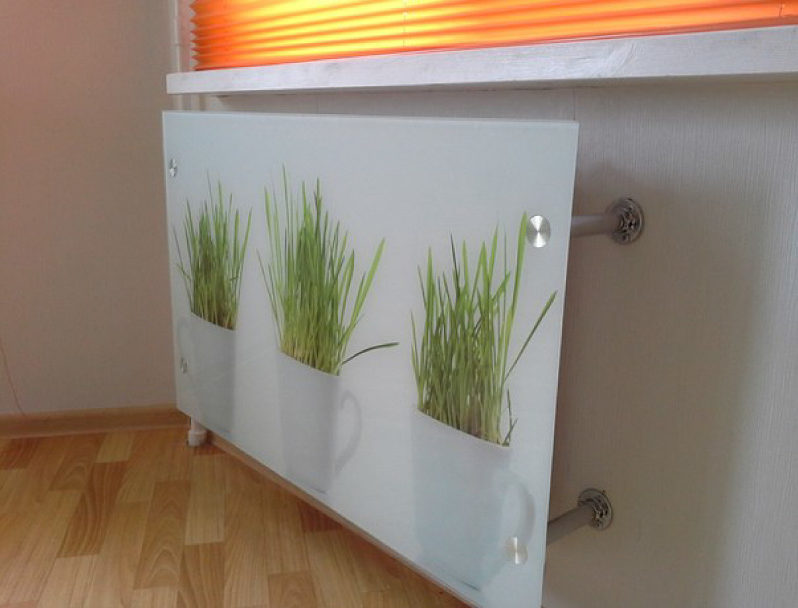
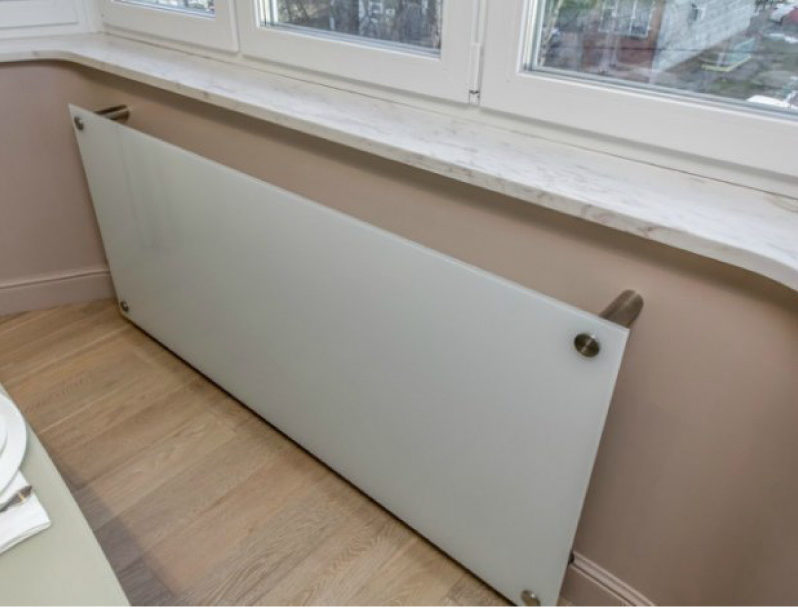
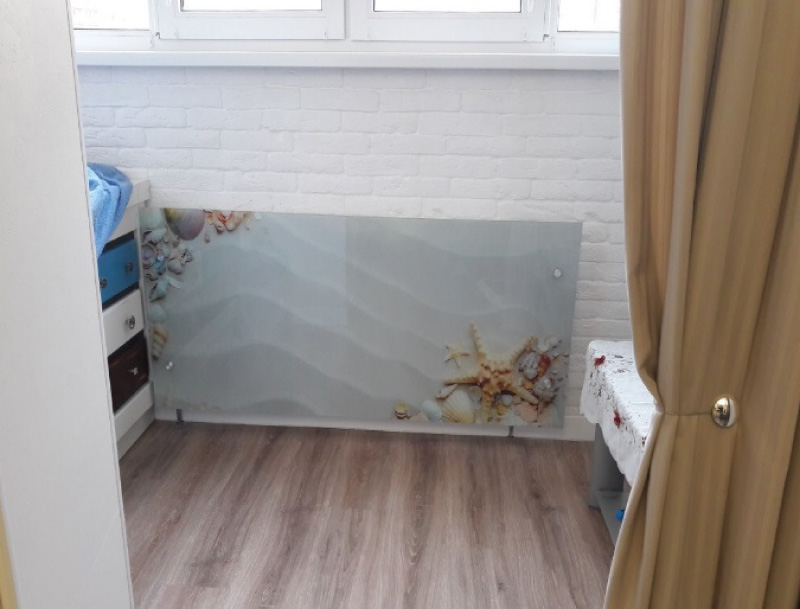
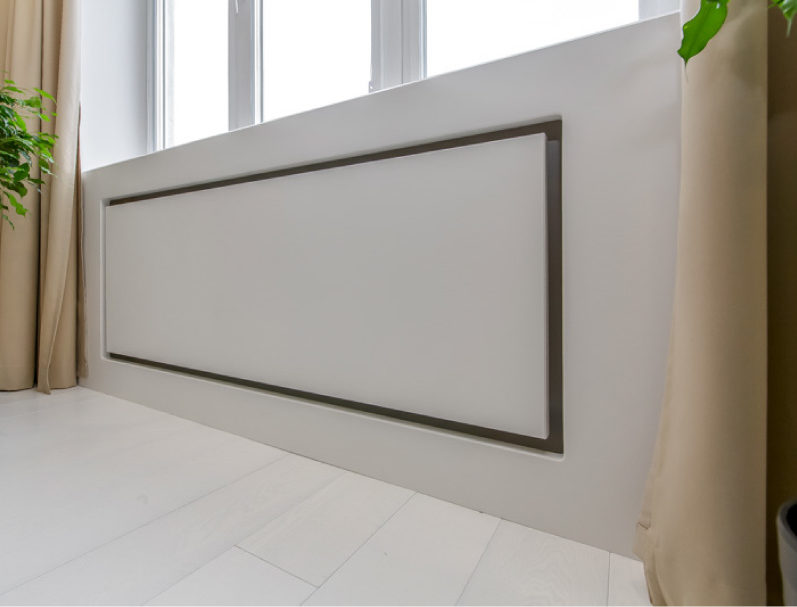
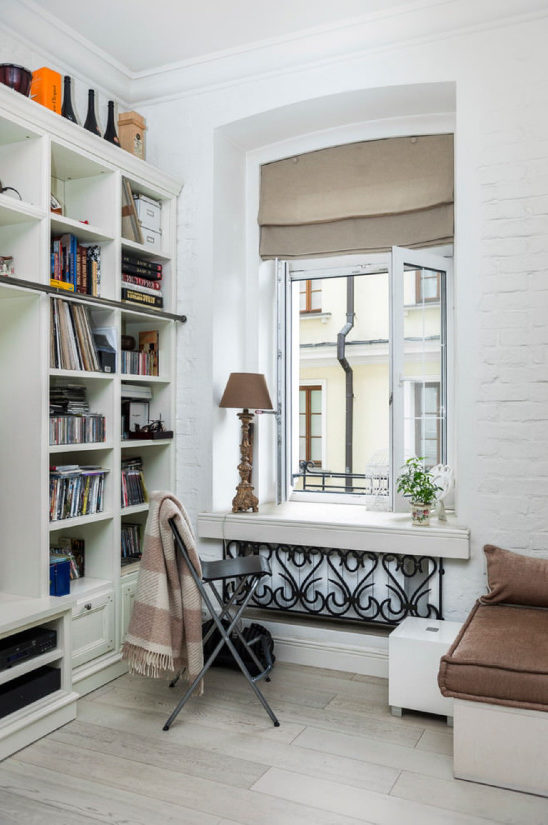
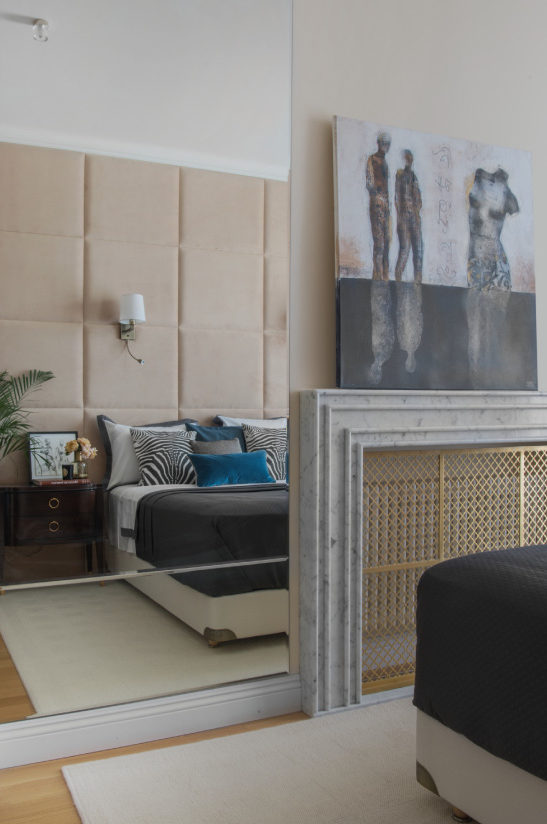
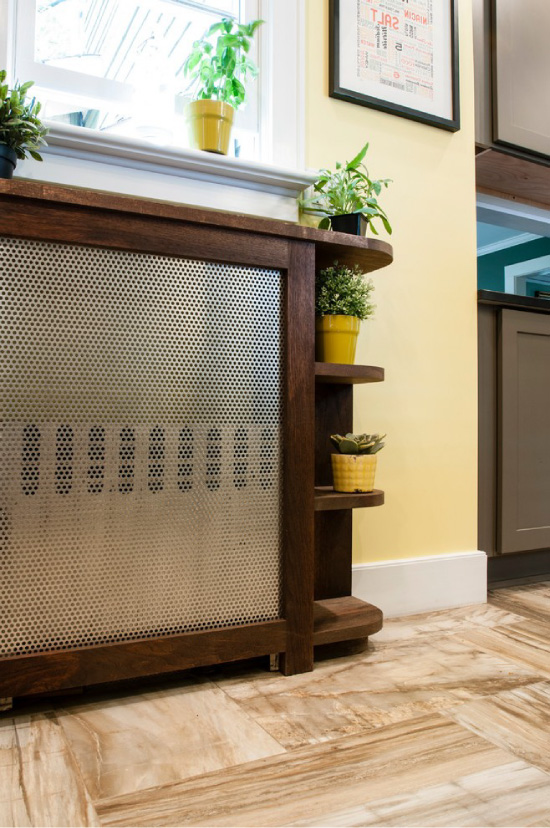
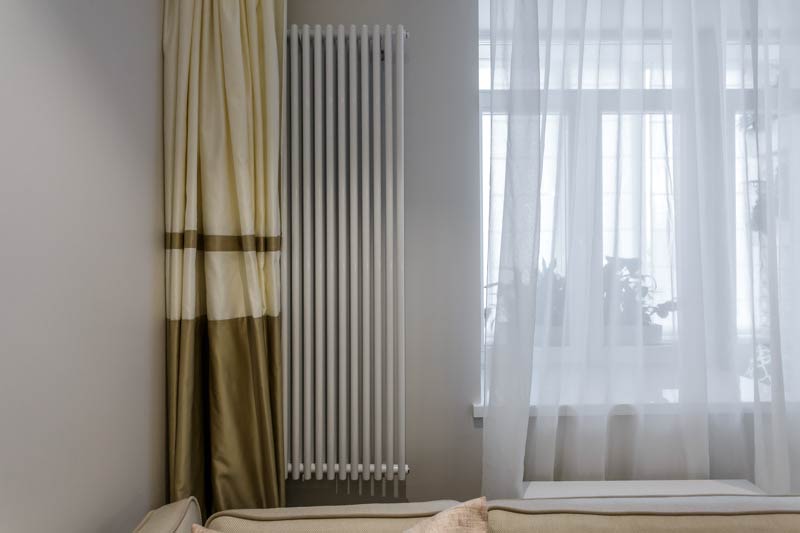
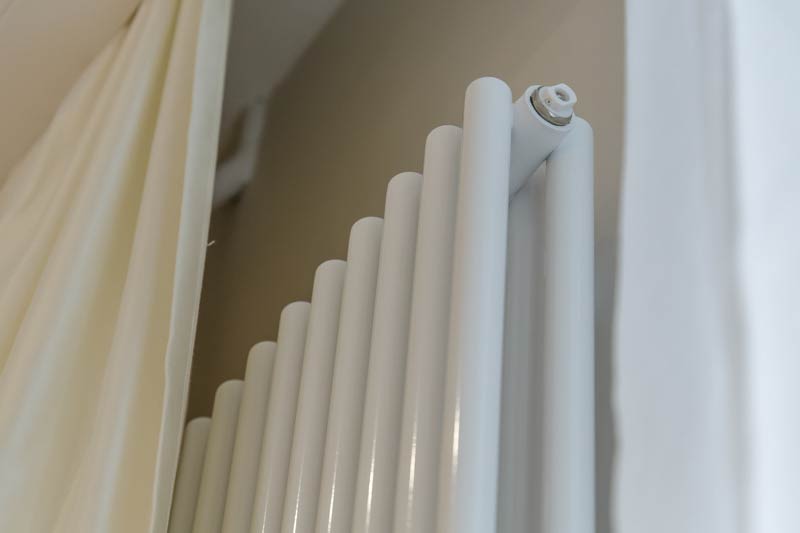
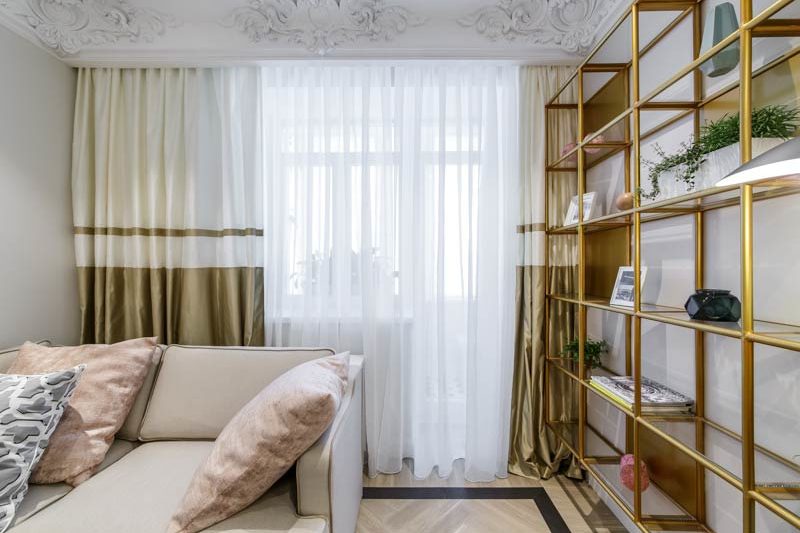
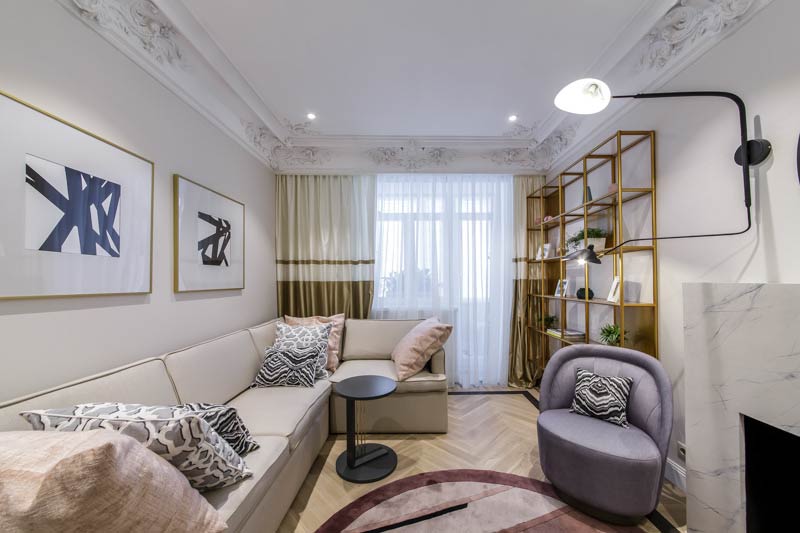
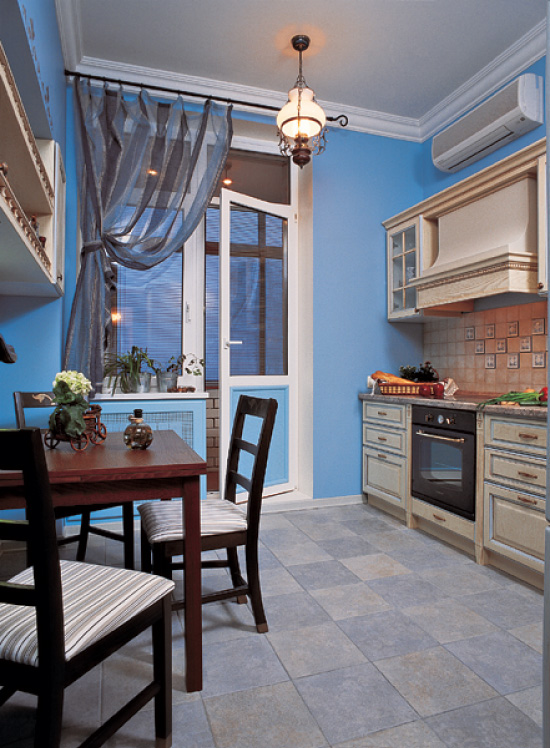
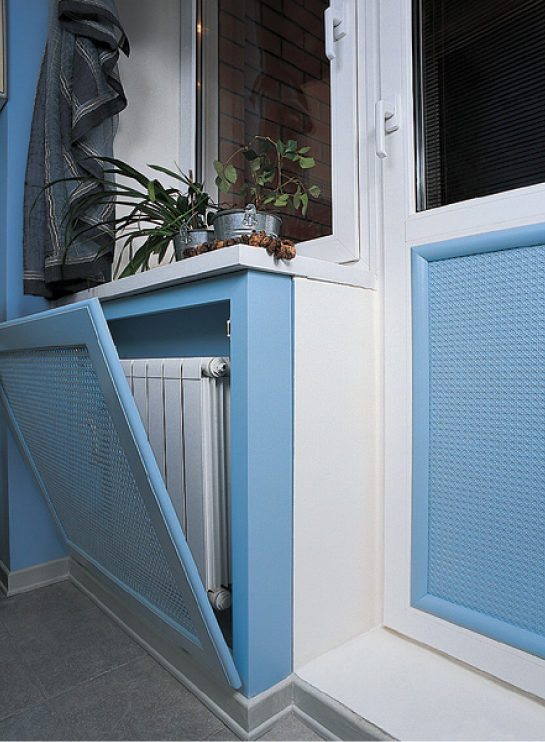

 (Rate the material! Already voted:6 average rating: 4,50 from 5)
(Rate the material! Already voted:6 average rating: 4,50 from 5)